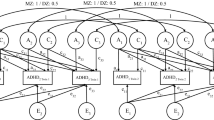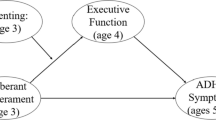Abstract
Low levels of childhood inhibitory control (IC) are phenotypically and genetically associated with externalizing behavior problems and attention deficit hyperactivity disorder (ADHD). Unfortunately, there is little research on this topic in early childhood, when IC first emerges. This investigation extends the previous findings of contemporaneous genetic covariance between parent-rated and laboratory-assessed IC and ADHD at age 2 by examining longitudinal links between IC at age two and ADHD behavior problems at age three in a sample of 314 same-sex twin pairs (145 monozygotic or MZ, 169 dizygotic or DZ). There were significant phenotypic associations between both parent and laboratory IC assessments at age two and later ADHD behavioral problems (correlations ranged from − .15 to − .44). In our model-fitting strategy, we included measures of ADHD and IC at age 2 as predictors of ADHD at age 3. Longitudinal genetic analyses showed that phenotypic covariance between age two IC and ADHD behavior problems one year later were explained by overlapping genetic variance (genetic correlations ranged from − .28 to − .60). However, these effects were not unique to IC and reflect variance shared with ADHD at age 2. Parent-rated IC at age two showed higher phenotypic and genetic covariance with ADHD at age three than lab ratings of IC at age two. This is the first investigation examining genetic covariance between parent and lab-based IC at age two and ADHD behavior problems at age three. Findings show that after accounting for co-occurring ADHD, early temperamental IC is not a unique genetic risk factor for later ADHD.



Similar content being viewed by others
Notes
We did not include age three IC data in our analyses because observed IC at age three was not genetically influenced (Gagne & Saudino, 2016).
References
Achenbach TM, Rescorla LA (2000) Manual for the ASEBA preschool forms and profiles. University of Vermont, Research Center for Children, Youth, and Families, Burlington, VT
Berger A (2011) Self-regulation: brain, cognition and development. American Psychological Association, Washington, DC
Campbell SB (1995) Behavior problems in preschool children: a recent review of the research. J Child Psychol 36:113–149
Carlson S (2005) Developmentally sensitive measures of executive function in preschool children. Dev Neuropsychol 28:595–616
Caspi A, Roberts BW, Shiner RL (2005) Personality development: stability and change. Annu Rev Psychol 56:453–484
Castellanos FX, Sonuga-Burke EJS, Milham MP, Tannock R (2006) Characterizing cognition in ADHD: beyond executive dysfunction. Trends Cogn Sci 10:117–123
Constantinidis C, Luna B (2019) Neural substrates of inhibitory control maturation in adolescence. Trends Neurosci 42:604–616
Demontis D, Walters RK, Martin J, Mattheisen M, Als TD et al (2019) Discovery of the first genome-wide significant risk loci for attention deficit/hyperactivity disorder. Nat Genet 51:63–75
Diamond A (1990) Developmental time course in human infants and infant monkeys, and the neural bases of inhibitory control in reaching. Ann NY Acad Sci 608:637–669
Diamond A (2013) Executive functions. Annu Rev Psychol 64:135–168. https://doi.org/10.1146/annurevpsych-113011-143750
Eisenberg N, Cumberland A, Spinrad TL, Fabes RA, Shepard SA, Reiser M, Valiente C, Murphy SH, Losoya SH, Guthrie IK (2001) The relations of regulation and emotionality to children’s externalizing and internalizing problem behavior. Child Dev 72:1112–1134
Eisenberg N, Sadovsky A, Spinrad TL, Fabes RA, Losoya SH, Valiente C, Reiser M, Cumberland A, Shepard SA (2005) The relations of problem behavior status to children’s negative emotionality, effortful control, and impulsivity; Concurrent relations and prediction of change. Dev Psychol 41:193–211
Eisenberg N, Spinrad TL, Fabes RA, Reiser M, Cumberland A, Shepard SA, Valiente C, Losoya SH, Guthrie IK, Thompson M (2004) The relations of effortful control and impulsivity to children’s resiliency and adjustment. Child Dev 75:25–46
Eisenberg N, Valiente C, Fabes RA, Smith CL, Reiser M, Shepard SA, Losoya SH, Guthrie IK, Murphy BC, Cumberland A (2003) The relations of effortful control and ego control to children’s resiliency and social functioning. Dev Psychol 39:761–776
Fagot J, Bonte E, Hopkins WD (2013) Age-dependant behavioral strategies in a visual search task in baboons (Papio papio) and their relation to inhibitory control. J Comp Psychol 127:194–201
Gagne JR (2017) Self-control in childhood: A synthesis of perspectives and focus on early development. Child Dev Perspect 11:127–132
Gagne JR, Goldsmith HH (2011) A longitudinal analysis of anger and inhibitory control in twins from 12 to 36 months of age. Dev Sci 14:112–124
Gagne JR, Saudino KJ (2010) Wait for it! The etiology of inhibitory control in early childhood. Behav Genet 40:327–337
Gagne JR, Saudino KJ (2016) The development of inhibitory control in early childhood: A twin study from 2–3 years. Dev Psychol 52:391–399
Gagne JR, Saudino KJ, Asherson P (2011a) The genetic etiology of inhibitory control and behavior problems at 24 months of age. J Child Psychol Psychiatry 52(11):1155–1163
Gagne JR, Van Hulle CA, Aksan N, Essex MJ, Goldsmith HH (2011b) Deriving childhood temperament measures from emotion-eliciting behavioral episodes: scale construction and initial validation. Psychol Assess 23(2):337–353
Goldsmith HH (1996) Studying temperament via construction of the Toddler Behavior Assessment Questionnaire. Child Dev 67:218–235
Goldsmith HH, Buss AH, Plomin R, Rothbart MK, Thomas A, Chess S, Hinde RA, McCall RB (1987) Roundtable: what is temperament? Four approaches. Child Dev 505–529
Goldsmith HH, Lemery KS, Essex MJ (2004) Temperament as a liability factor for childhood behavioral disorders: The concept of liability. In: DiLalla LF (ed) Behavior genetics principles: perspectives in development, personality, and psychopathology. American Psychological Association, Washington, DC, pp 19–39
Goldsmith HH, Reilly J, Lemery KS, Longley S, Prescott A (1995) Preliminary manual for the preschool laboratory temperament assessment battery (version 1.0). Technical Report, Department of Psychology, University of Wisconsin-Madison
Goos LM, Crosbie J, Payne S, Schachar R (2009) Validation and extension of the endophenotype model. J Psychiatry 166:711–717
Gottesman II, Gould TD (2003) The endophenotype concept in psychiatry: etymology and strategic intentions. Am J Psychiatry 160:636–645
Griffin D, Gonzalez R (1995) Correlational analysis of dyad-level data in the exchangeable case. Psychol Bull 118:430–439
Keenan K, Wakschlag L (2000) More than the terrible twos: The nature and severity of behavior problems in clinic-referred preschool children. J Abnorm Child Psychol 28:33–46
Kochanska G, Murray KT, Harlan ET (2000) Effortful control in early childhood: Continuity and change, antecedents, and implications for social development. Dev Psychol 36:220–232
Kochanska G, Murray K, Jacques TY, Koenig AL, Vandegeest KA (1996) IC in young children and its role in emerging internalization. Child Dev 67:490–507
Lemery KS, Essex MJ, Smider NA (2002) Revealing the relation between temperament and behavior problem symptoms by eliminating measurement confounding: expert ratings and factor analyses. Child Dev 73:867–882
Lemery-Chalfant K, Doelger L, Goldsmith HH (2008) Genetic relations between effortful control and attentional control symptoms of psychopathology in middle childhood. Infant Child Dev 17:365–385
Liang KY, Zeger SL (1986) Longitudinal data analysis using generalized linear models. Biometrika 73:13–22
Liew J (2012) Effortful control, executive functions, and education: bringing self-regulatory and social-emotional competenices to the table. Child Dev Perspect 6:105–111
McGue M, Bouchard TJ Jr (1984) Adjustment of twin data for the effects of age and sex. Behav Genet 14:325–343
Metcalfe J, Mischel W (1999) A hot/cool system analysis of delay of gratification: dynamics of willpower. Psychol Rev 106:3–19
Neale MC (2003) Mx: statistical modeling (6th ed.) Medical College of Virginia: Department of Psychiatry
O’Connor BP (2004) SPSS and SAS programs for addressing interdependence and basic levels-of-analysis issues in psychological data. Behav Res Meth Instr C 36:17–28. https://doi.org/10.3758/BF03195546
Polderman TJC, de Geus EJC, Hoekstra RA, Bartels M, van Leeuwen M, Verhulst FC, Posthuma D, Boomsma DI (2009) Attention problems, inhibitory control, and intelligence index overlapping genetic factors: a study in 9-, 12-, and 18-year-old twins. Neuropsychology 23:381–391
Rothbart MK (1989) Temperament and development. In: Kohnstamm GA, Bates JA, Rothbart MK (eds) Temperament in childhood. Wiley, New York, pp 187–247
Rothbart MK, Ahadi SA (1994) Temperament and the development of personality. J Abnorm Psychol 103:55–66
Rothbart MK, Bates JE (2006) Temperament. In Eisenberg N (ed) Handbook of child psychology, 6th edn., vol 3. Social, emotional, and personality development). Wiley, Hoboken, pp 99–166
Saudino KJ (2005) Multiple informants. In Everitt B, Howell D (eds) Encyclopedia of statistics in behavioral science, vol 4. Wiley, Chichester, UK, pp 1332–1333
Saudino KJ, Asherson P (2013) The Boston University Twin Project (BUTP). Twin Res Hum Genet 16:449–450. https://doi.org/10.1017/thg.2012.64
Saudino KJ, Carter AS, Purper-Ouakil D, Gorwood P (2008) The etiology of behavioral problems and competencies in very young twins. J Abnorm Psychol 117:48–62
Schachar R, Tannock R, Marriott M, Logan G (1995) Deficient IC in attention deficit hyperactivity disorder. J Abnorm Child Psychol 23:411–437
Shiner, R. L., Buss, K. A., McClowry, S. G., Putnam, S. P., Saudino, K. J., & Zentner, M. (2012). What is temperament now? Assessing progress in temperament research on the twenty-fifth anniversary of Goldsmith et al (1987). Child Dev Perspect 6(4), 436–444.
Thissen AJAM, Rommelse NNJ, Hoekstra PJ, Hartman C, Heslenfeld D, Luman M, van Lieshout M, Franke B, Oosterlaan J, Buitelaar JK (2014) Attention deficit hyperactivity disorder (ADHD) and executive functioning in affected and unaffected adolescents and their parents: challenging the endophenotype construct. Psychol Med 44:881–892
Uebel H, Albrecht B, Asherson P, Borger NA, Butler L, Chen W, Christiansen H (2010) Performance variability, impulsivity errors and the impact of incentives as gender-independent endophenotypes for ADHD. J Child Psychol Psychiatry 51:210–218
Vlamings PHJM, Hare B, Call J (2010) Reaching around barriers: the performance of the great apes and 3–5-year-old children. Anim Cognit 13:273–285
Yang L, Neale BM, Liu L, Lee SH, Wray NR, Ji N, Li H, Qian Q, Wang D, Li J, Faraone SV, Wang Y, Psychiatric GWAS Consortium: ADHD Subgroup (2013) Polygenic transmission and complex neuro developmental network for attention deficit hyperactivity disorder: genome-wide association study of both common and rare variants. Am J Med Genet B Neuropsychiatr Genet 162B:419–430
Zeger SL, Liang KY (1986) Longitudinal data analysis for discrete and continuous outcomes. Biometrics 42:121–130
Author information
Authors and Affiliations
Corresponding author
Ethics declarations
Conflict of interest
Jeffrey R. Gagne, Philip Asherson, and Kimberly J. Saudino declare that they have no conflict of interest.
Human and Animal Rights and Informed Consent
All surveys, assessments, and recruitment protocols were followed in accordance with IRB approval. No animal subjects were used in the studies and no human experimental protocols were carried out. Informed consent was obtained from all participants before enrollment in the study.
Additional information
Publisher's Note
Springer Nature remains neutral with regard to jurisdictional claims in published maps and institutional affiliations.
Rights and permissions
About this article
Cite this article
Gagne, J.R., Asherson, P. & Saudino, K.J. A Twin Study of Inhibitory Control at Age Two and ADHD Behavior Problems at Age Three. Behav Genet 50, 289–300 (2020). https://doi.org/10.1007/s10519-020-09997-5
Received:
Accepted:
Published:
Issue Date:
DOI: https://doi.org/10.1007/s10519-020-09997-5




